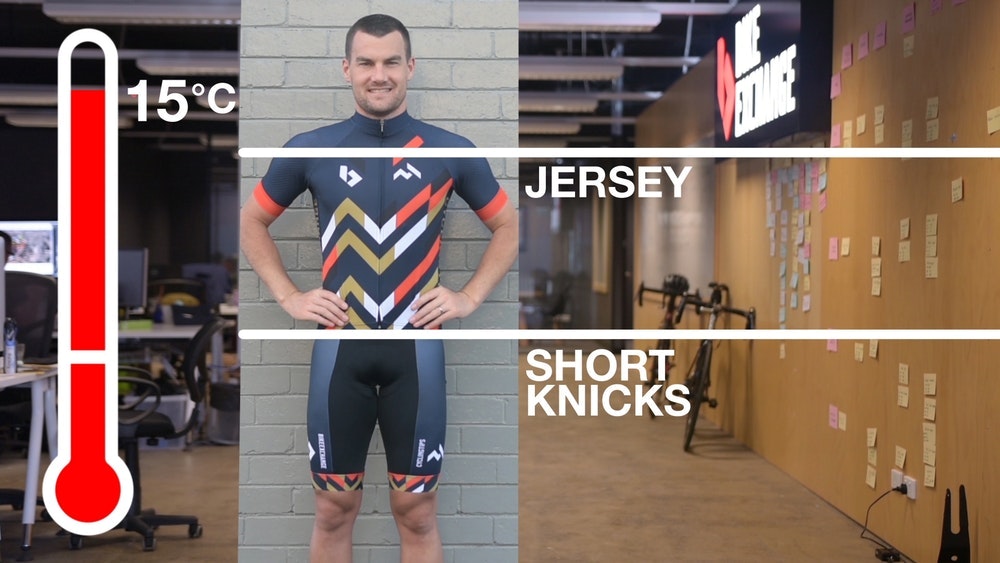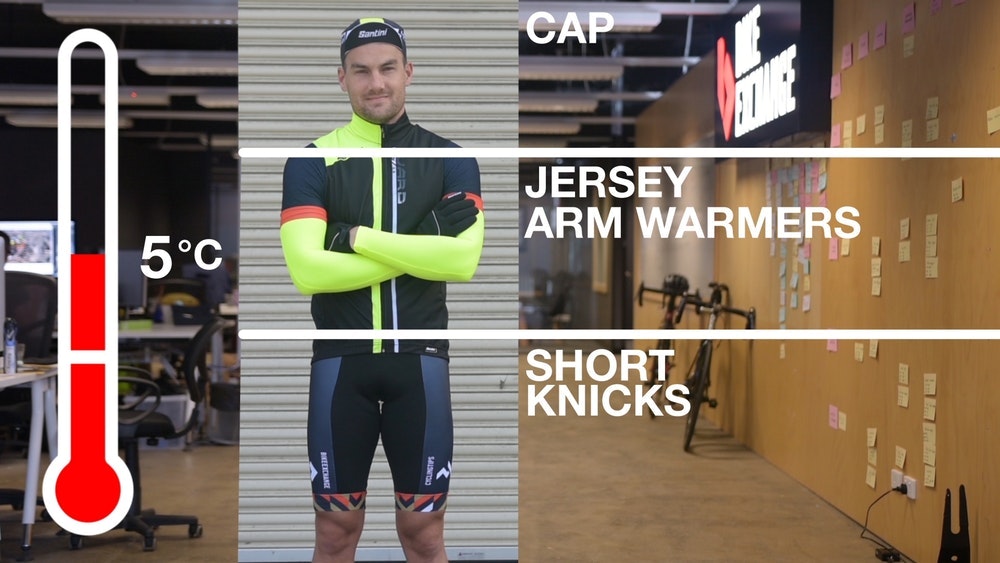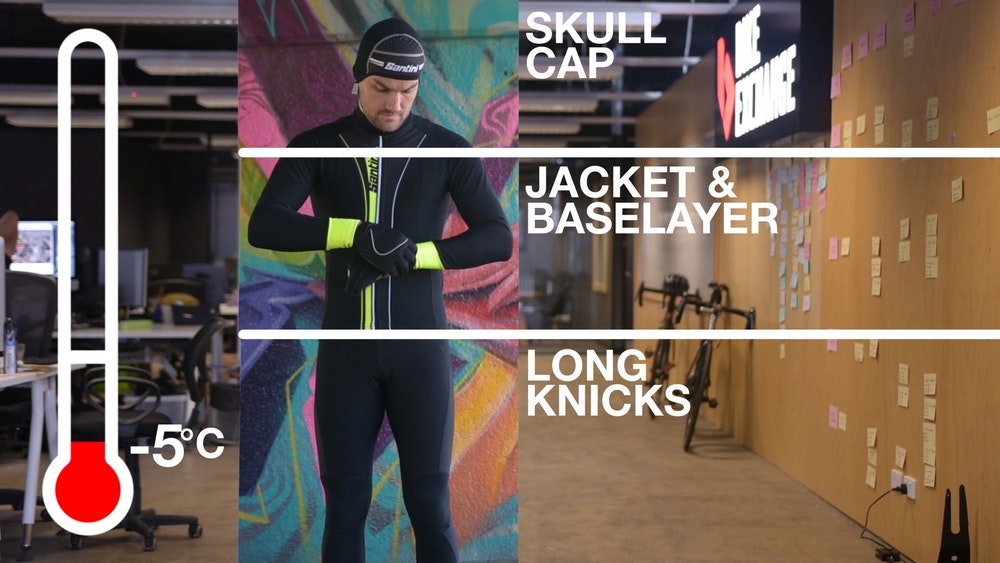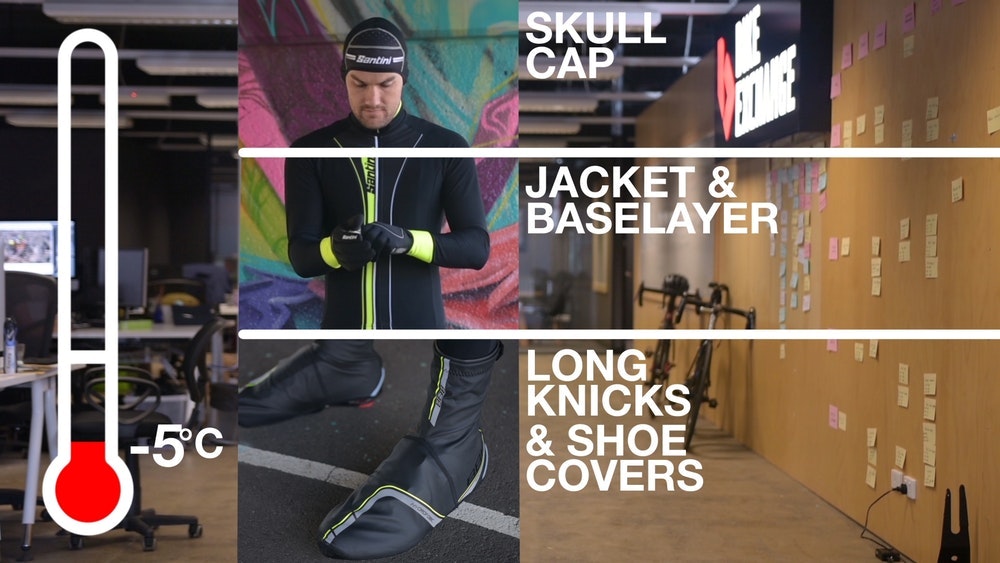Moreso than any other season, winter is a time to focus on function over fashion. There are not many things worse than being cold on the bike. Once you are cold, there's no escaping it, quickly turning your ride into a miserable experience.
A good rule of thumb when layering up or dressing for cold weather is to choose your clothes for 15 minutes into your ride, not for when you start riding. As soon as you set off, your heart rate and blood flow will increase, and your body temperature will rise. If you have overdressed, you will become too hot and spend the remainder of your ride sweating and uncomfortable. It's worth having several cold minutes at the start of your ride to enjoy the rest of it.
Before you begin to layer up, think about your ride: how long is it? Is it going to be a smooth or hard ride? Are you going to be climbing and descending frequently? Are you going to stop for a 30-minute coffee debrief afterwards?
All of these factors (and many more) will influence the amount of clothing you will need and the layers you should adopt. The number one goal when dressing for cold temperatures is to keep your core dry and warm. Generally speaking, riding in the colder months also means riding in the dark, so where possible choose bright colours and clothes with reflective strips to make it easy for others to see you.
Here are some great tips for how to layer up and stay warm in all temperatures.
Above 15 degrees: Standard kit, the perfect temperature for riding a bike

15 degrees or over is the ideal riding temperature and doesn't take a lot of preparation or layering. A thin base layer, knicks, jersey, socks and short finger gloves are all you need.
When choosing a base layer for this temperature, be aware that base layers come in many different shapes, sizes, and thicknesses. Sleeveless base layers are perfect for milder temperatures where you just want to take the edge off any chill and keep your core warm. As the temperature begins to drop, short sleeve base layers offer slightly more insulation and coverage without the bulk of a full arm sleeve. When the temperature plummets, look for an insulated long-sleeve base layer with some kind of thermogenic element.
A good base layer that will keep you warm and wick sweat away is worth its weight in gold. To choose a functional base layer, look for a garment that will wick away sweat, is made from breathable materials, and doesn't feel like you are wearing a sweater underneath your kit. Base layers can be made from synthetic fabric, merino wool, cotton, polyester or a combination blend of each.
Between 5 degrees and 15: Layer Up

Gilet or Vest
Taking a gilet or vest with you on any ride is always a good option. Modern gilets or vests are lightweight, windproof and can be packed away, taking up virtually no space at all. They are perfect on warmer days when descending to prevent your core from cooling down, and ideal for cooler days to add an extra layer of warmth and avoid the cold wind giving you a chill. As the temperature gets closer to 5 degrees, going one step further and getting an insulated or thicker gilet or vest is the best option. This will help keep your core warm, prevent the wind from cooling you down and can easily be unzipped to help regulate temperature.
Some gilets or vests will also come with pockets which can be advantageous during long rides as it means you can store more food, kit or remove items and store them as you go.
Arm warmers
Arm warmers are essential for this temperature range for the same reason gilets or vests are: they are lightweight, provide excellent warmth and protection from the wind, and pack down to virtually nothing if required. Arm warmers come in varying levels of thickness and insulation. As the temperature really drops, choosing arm warmers with a Windstopper and waterproof outer combined with a fleece under layer is the best option.
Long finger gloves
The line in the sand between long and short finger gloves will depend on individual preference and tolerance for the cold, but it is an essential change. Being able to brake and change gears is crucial to riding a bike, two things that are hard to do if you can't feel your fingers.
Long finger gloves come in many forms from thin, lightweight options all the way to windproof, waterproof, neoprene, insulated, bullet-proof protection for your hands. It's important to remember that your hands and feet are the furthest from your core so they will feel the cold before anything else. Pay particular attention to keeping your core warm; this will help keep your extremities warm.
Cap
A cap is an optional accessory in all weather, but it's worth considering in colder temperatures as we lose a large amount of heat from the top of our heads. Having a cap on will help trap that heat in and keep you warm without having to wear excessive layers.
Toe covers / Belgian Booties
As mentioned above, your hands and feet are the furthest from your core and will feel the cold before anything else. Keeping them warm is essential for not only performance but also the enjoyment of your ride. Avoid the temptation to wear thick socks or double socks in cold weather, as this has the potential to limit circulation to your feet. They could quickly become numb and ruin your ride. Keep your feet warm from the outside by wearing toe covers or Belgian booties (a thin shoe cover for intermediate temperatures).
Below 5º: Batten Down the Hatches

Jacket
A good winter jacket can be the difference between training through winter and starting spring behind the eight-ball. A good winter jacket will also mean you don't have to wear excessive layers, on most occasions a good thermal base layer and winter jacket should do the trick. A good winter jacket should be windproof, waterproof, insulated and breathable.
Here are some critical areas to consider when purchasing a jacket to get you through winter:
The neck: The neck needs to be high to keep you warm and cover as much of your skin as possible. Skin exposed to the elements will become cold very quickly.
The arms: The sleeves on your jacket need to go past the wrist in the riding position so that there is no exposed skin between your gloves and jacket. When you are trying on a winter jacket, be sure to do so on the bike, not just standing up in the store.
The back: Make sure that the back of your jacket goes below your hips. This will not only keep your lower back and kidneys warm, but it will also prevent dirt and grime spraying up onto your knicks (assuming to don't have an 'ass-saver' connected to your bike). Good jackets will have this lower back as a flap that can be folded away if required.
Jackets will also come in handy if the weather turns, or if you end up on the side of the road because of a mechanical issue or crash.
Full-length thermal knicks
Purchasing full-length knicks will change your life... well, maybe that's a little dramatic, but they will undoubtedly change your approach to riding in cold temperatures. Full- length thermal knicks are exceptionally warm, generally with a fleece inner and windproof outer that keep your legs warm in the coldest of temperatures. Most importantly, it will keep your knees warm, which can 'freeze up,' affecting the quality of your ride and potentially cause tendinosis/bursitis type issues if you try to overexert yourself while your muscles are stiff, cold and inflexible.
Another option if you don't fancy purchasing full-length thermal knicks (obviously because you can only wear them when the temperatures are cold), is thermal tights without a chamois. These can be a great addition to your cycling wardrobe adding an extra layer of warmth and cheaper than buying a full-length set of knicks.

Headband / Skull Cap
As mentioned previously, we lose a large amount of heat through the tops of our head, a skull cap will trap the heat in, not to mention cover your ears and keep your forehead warm. Most skull caps will have a thicker section to cover the forehead, while the remainder is made from a lightweight, breathable material to prevent overheating.
Insulated gloves
At these temperatures, long-finger lightweight gloves won't be enough to keep your hands warm. Look for an insulated glove with Windstopper material on the outside that also has waterproof properties. It's worth considering putting a pair of inners underneath your gloves to add an extra layer of warmth if you suffer from poor circulation.
A Neoprene glove is also an option. Neoprene is a wetsuit-like material that is water repellant, helping keep you dry and also providing great insulation for your hands. It's not the most breathable fabric, so consider wearing inners underneath or be prepared to have sweaty palms at the end of your ride.
Neoprene overshoes
Neoprene overshoes are an excellent option for your feet for the same reason they are great for your hands. Neoprene is waterproof, windproof and provides excellent insulation.
10º Below: Forget it!
Hit the snooze button or jump on the trainer.
Shop a wide range of clothing, warmers and accessories at BikeExchange.




